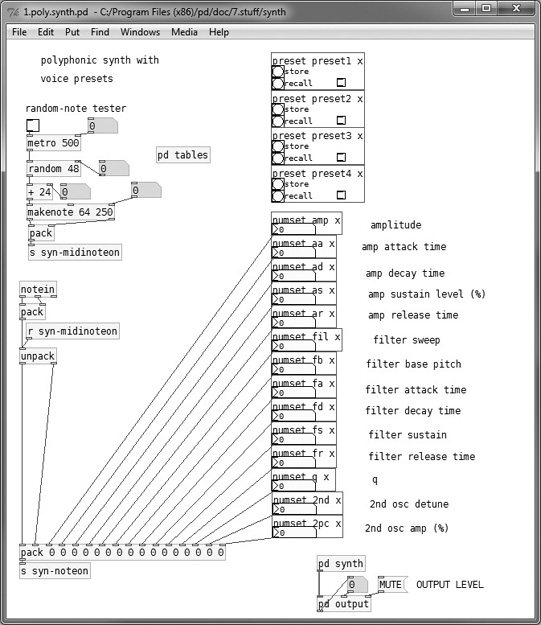Alternatives
The three programs most widely used by computer musicians who favor free, open-source software are Csound, Pd, and SuperCollider. They’re about as different from one another as could be imagined, but they have one thing in common: Each of them will require some mental effort to learn.
Figure 1.5 Pd, created by Miller Puckette, is a graphical programming system for music. It can be downloaded from http://puredata.info. In Pd, you create and process sounds by patching together on-screen boxes, using the mouse to drag virtual patch cords from one box to another. Pd has a large and active user community and excels at real-time interactive music-making. It also has real-time video processing capabilities.

Each of them is right for some musicians, and each is better than the others at certain musical tasks. Many people use two or even all three of them at different times, and for different purposes. This is not the place for a detailed comparison—nor am I necessarily the best person to make such a comparison. I’ve used Csound a good deal, Pd from time to time, and SuperCollider hardly at all. Of the three, Csound has both the longest history and arguably the largest set of features. But that hardly matters. What matters is making music, and it’s quite possible to make sophisticated music for years without using more than a fraction of Csound’s total feature set. In this book I’ll have a great deal to say about how to make music with Csound. (We’ll also take a quick look, in Chapter 10, about how to use Csound within Pd.)
Before committing to Csound, you might want to download and install the other two and take a quick look at them. Pd is preferred by some musicians because they find its graphic depiction of signal routings intuitively easy to grasp. SuperCollider is, like Csound, a text-based music creation system. It uses a more modern, object-oriented syntax, which is powerful but perhaps not as intuitively obvious as Csound’s procedural code, especially to the non-programmer. SuperCollider can be downloaded from http://supercollider.sourceforge.net.
All three systems understand the OSC communications protocol, so if you’re willing to take the time to learn more than one system, you can use each of them for its own strengths and combine them into a multifaceted real-time music-making machine.
